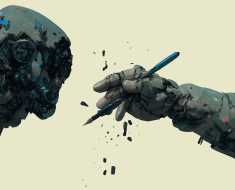As we look forward to 2025, the world of AI graphic design is brimming with potential and innovation. The integration of artificial intelligence into graphic design is not just a passing trend; it’s a fundamental shift in how creative processes are executed. From generating photorealistic images to crafting personalized design experiences, AI graphic design is redefining the boundaries of creativity. This article highlights the latest trends in AI graphic design, focusing on how these advancements are shaping the future of the industry.
Photorealistic Image Generation: A New Era in Visuals


Photorealistic image generation stands out as a significant trend in AI graphic design. Imagine creating visuals so realistic that they could easily be mistaken for actual photographs. AI tools like Midjourney¹ and DALL-E¹ have made this a reality, enabling designers to produce highly detailed and lifelike images. This trend is revolutionizing industries such as advertising, product design, and digital art by providing a cost-effective and efficient alternative to traditional photography. The advantages of photorealism in AI graphic design are manifold. It saves time and resources by eliminating the need for physical photoshoots and prototypes. For example, an e-commerce company can quickly generate realistic images of products in various settings, enhancing marketing strategies and consumer engagement². This capability allows designers to experiment with different concepts and iterate rapidly, keeping pace with the ever-changing market demands.
Personalized Design Experiences: Tailoring Creativity


In the digital age, personalization is paramount. AI graphic design is embracing this trend by offering personalized design experiences that cater to individual user preferences. By analyzing user data, AI can customize design elements, creating interfaces that resonate on a personal level. This trend is particularly evident in web design, where AI can adjust layouts, color schemes, and content based on user behavior³. Personalized design experiences enhance user engagement by making interactions more relevant and intuitive. For instance, a website might highlight products that align with a user’s past purchases, increasing the likelihood of conversion. As AI graphic design continues to evolve, delivering personalized experiences will become a standard expectation in graphic design. This trend not only improves user satisfaction but also builds brand loyalty by creating a more meaningful connection with the audience.
AI in UX/UI Design: Crafting Seamless Interactions


User experience (UX) and user interface (UI) design are critical components of any digital product. AI graphic design plays a crucial role in transforming these areas by enabling the creation of interfaces that adapt to user needs in real-time. This adaptability is essential in a world where user expectations are constantly evolving. AI in UX/UI design helps create more intuitive and user-friendly interfaces. By analyzing user interactions, AI can predict user needs and streamline navigation paths, resulting in a smoother experience⁴. This trend is particularly important for mobile applications, where screen space is limited and efficient design is paramount. For instance, an app might use AI graphic design to rearrange its interface based on the user’s most frequently used features, making the app more intuitive and enjoyable to use.
Generative AI: Expanding Creative Horizons


Generative AI is opening new doors for creativity in AI graphic design. These tools can generate a wide range of design elements, from simple graphics to complex compositions, based on input parameters provided by the designer. This capability allows designers to explore creative possibilities that might not have been feasible through traditional methods. Generative AI democratizes creativity by making it accessible to a broader audience. Designers can experiment with different styles and techniques without needing extensive technical skills. This trend empowers both novice and experienced designers to push the boundaries of their creativity and produce innovative designs. For example, a designer might use generative AI graphic design to quickly prototype multiple logo concepts, allowing for rapid iteration and refinement⁵.
AI in Typography: Breathing New Life into Text Design
Typography is a fundamental element of graphic design, and AI graphic design is making significant strides in this area. AI-powered tools can automate font pairing, adjust kerning, and even create entirely new typefaces. These advancements allow designers to focus on the overall design strategy rather than getting bogged down in the minutiae of text formatting. AI in typography not only improves efficiency but also opens up new avenues for creative expression. Designers can experiment with dynamic and responsive typography that adapts to different contexts and user interactions⁶. This flexibility is particularly valuable in digital media, where text needs to be legible and visually appealing across various devices and screen sizes. For instance, a website might use AI graphic design to adjust its typography based on the user’s device, ensuring optimal readability and aesthetic appeal.
Ethical Considerations and Challenges in AI Graphic Design


While the benefits of AI graphic design are substantial, there are also ethical considerations and challenges to address. Issues such as data privacy, intellectual property rights, and algorithmic bias are critical concerns that need careful attention⁷. As AI-generated designs become more prevalent, the industry must establish guidelines and standards to ensure ethical practices. Designers and organizations must navigate these challenges by fostering transparency and accountability in AI graphic design processes. This includes understanding the limitations of AI tools and being mindful of the potential biases that may arise from the data used to train these systems. By addressing these issues proactively, the graphic design industry can harness the full potential of AI while maintaining ethical integrity.
Conclusion: Embracing the Future of AI Graphic Design
The integration of AI graphic design is ushering in a new era of creativity and innovation. From photorealistic image generation to personalized design experiences, AI graphic design is transforming the way designers work and interact with their audiences. As we move into 2025, staying informed about these trends will be crucial for designers who wish to remain competitive and relevant in the ever-evolving design landscape. By embracing AI’s capabilities and addressing its challenges, the graphic design industry can look forward to a future filled with exciting possibilities.
Citations:
1. Midjourney. (n.d.). Midjourney.
3. Luigi’s Box. (n.d.). E-commerce AI Trends.
4. Nielsen Norman Group. (2023). AI in UX.
5. Coursera. (2023). Generative AI Applications
6. ScienceDirect. (2023). Typography in Digital Media
7. Parachute Design. (n.d.). Ethics of AI in Design.
Please note, that the author may have used some AI technology to create the content on this website. But please remember, this is a general disclaimer: the author can’t take the blame for any mistakes or missing info. All the content is aimed to be helpful and informative, but it’s provided ‘as is’ with no promises of being complete, accurate, or current. For more details and the full scope of this disclaimer, check out the disclaimer page on the website.





